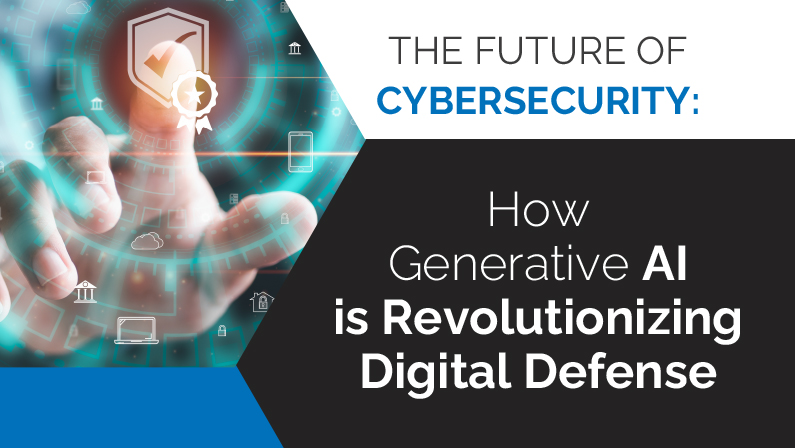Generative AI is an innovative technology that uses machine learning algorithms to create and adapt models by learning from vast amounts of data. This powerful tool is now being harnessed in the fight against cybercrime. By analyzing patterns, detecting anomalies, and predicting future threats, generative AI offers unprecedented defense capabilities.
With generative AI, cybersecurity experts can anticipate the ever-evolving tactics of cybercriminals, enhancing their ability to detect and mitigate threats in real-time. By automating threat detection and response, generative AI allows organizations to stay one step ahead of hackers and safeguard their sensitive information.
As we explore the future of cybersecurity in this article, we will delve into the practical applications of generative AI and its potential to revolutionize digital defense. Join us as we uncover the cutting-edge technology that is shaping the way we protect ourselves in the digital age.
The Rise of Generative AI in Cybersecurity
Enter generative AI, a revolutionary technology that is changing the game in cybersecurity. Generative AI uses machine learning algorithms to create and adapt models by learning from vast amounts of data. This powerful tool has the potential to transform digital defense by analyzing patterns, detecting anomalies, and predicting future threats.
Generative AI works by training models on large datasets of known cyber threats, allowing it to identify patterns and characteristics that are indicative of malicious activity. This enables cybersecurity experts to proactively detect and mitigate threats in real-time, rather than relying on reactive measures after an attack has occurred.
Understanding Generative AI and Its Benefits
Generative AI works by generating new data that is similar to the training data it has been fed. This means that it can create new instances of cyber threats, even if it has never encountered them before. By constantly learning and adapting, generative AI can stay ahead of cybercriminals who are constantly evolving their tactics.
One of the key benefits of generative AI in cybersecurity is its ability to automate threat detection and response. Traditional approaches often rely on manual analysis and investigation, which can be time-consuming and prone to human error. With generative AI, organizations can streamline their cybersecurity operations, freeing up valuable time and resources for other
critical tasks.
Generative AI also offers the advantage of scalability. As the volume and complexity of cyber threats continue to increase, organizations need a solution that can keep up with the demand. Generative AI can process vast amounts of data in real-time, quickly identifying and responding to threats at scale.
How Generative AI is Revolutionizing Digital Defense
Generative AI is revolutionizing digital defense by empowering cybersecurity experts to anticipate and counter the ever-evolving tactics of cybercriminals. By analyzing vast amounts of data and identifying patterns, generative AI can detect anomalies and predict future threats.
One of the key ways generative AI is enhancing digital defense is through its ability to detect and identify zero-day vulnerabilities. Zero-day vulnerabilities are previously unknown software flaws that can be exploited by hackers. Traditional approaches often struggle to keep up with these rapidly emerging threats, leaving organizations vulnerable. Generative AI, on the other hand, can
identify and patch these vulnerabilities before they can be exploited.
Generative AI is also being used to enhance threat hunting, a proactive approach to cybersecurity that involves actively searching for threats within an organization's network. By analyzing network traffic and system logs, generative AI can identify suspicious activities and flag them for further investigation. This allows cybersecurity experts to focus their efforts on the most critical threats, improving their overall response time and effectiveness.
Real-Life Examples of Generative AI in Cybersecurity
Generative AI is already making waves in the field of cybersecurity, with several real-life examples showcasing its potential. One such example is the use of generative AI in phishing detection. Phishing attacks are one of the most common and effective methods used by cybercriminals to gain unauthorized access to sensitive information. Traditional approaches to phishing detection often rely on static rules and signatures, making them ineffective against sophisticated attacks. Generative AI, on the other hand, can analyze patterns and characteristics of phishing emails, enabling organizations to detect and block them in real-time.
Another example of generative AI in cybersecurity is the use of anomaly detection. Anomalies are deviations from normal behavior and can indicate the presence of a cyber threat. Traditional approaches to anomaly detection often struggle to distinguish between legitimate anomalies and malicious activities. Generative AI, however, can analyze vast amounts of data and identify anomalies that are indicative of a cyber attack. This allows organizations to respond quickly and effectively, minimizing the potential damage.
Limitations and Challenges of Generative AI in Cybersecurity
While generative AI offers unprecedented defense capabilities, it is not without its limitations and challenges. One of the main challenges is the availability of high-quality training data. Generative AI relies on large datasets of known cyber threats to learn and adapt. However, obtaining and maintaining these datasets can be a daunting task. Cyber threats are constantly changing, and organizations need to constantly update their training data to ensure the accuracy and effectiveness of their generative AI models.
Another challenge is the potential for false positives and false negatives. False positives occur when generative AI incorrectly identifies a benign activity as a cyber threat, leading to unnecessary alerts and disruptions. False negatives, on the other hand, occur when generative AI fails to detect a genuine cyber threat. Striking the right balance between accuracy and
effectiveness is crucial in ensuring the success of generative AI in cybersecurity.
Additionally, there are ethical considerations that need to be taken into account when using generative AI in cybersecurity. Generative AI has the potential to create new instances of cyber threats, even if it has never encountered them before. This raises concerns about the responsible use of this technology and the potential for unintended consequences.
The Future of Generative AI in Cybersecurity
Despite the challenges, the future of generative AI in cybersecurity looks promising. As the technology continues to evolve and improve, we can expect to see even more advanced and sophisticated generative AI models that are capable of defending against the most advanced cyber threats.
One area where generative AI holds great promise is in the field of predictive analytics. By analyzing vast amounts of historical data, generative AI can identify patterns and trends that can help predict future cyber threats. This proactive approach to cybersecurity can significantly enhance an organization's ability to defend against emerging threats.
Another area where generative AI is expected to make a significant impact is in the field of autonomous response. Currently, cybersecurity operations often rely on manual analysis and investigation, which can be slow and prone to human error. Generative AI has the potential to automate these processes, allowing organizations to respond to threats in real-time and at scale.
The Role of Human Intelligence in Conjunction with Generative AI
While generative AI offers powerful defense capabilities, it is important to recognize the role of human intelligence in conjunction with this technology. Generative AI is a tool that can assist cybersecurity experts in their efforts to detect and mitigate threats. Human intelligence, on the other hand, brings critical thinking, intuition, and creativity to the table. By combining the strengths of generative AI and human intelligence, organizations can create a formidable defense against cyber threats.
Cybersecurity experts play a vital role in training and fine-tuning generative AI models. They provide the expertise and domain knowledge necessary to ensure the accuracy and effectiveness of the models. Additionally, human intelligence is crucial in interpreting the output of generative AI models and making informed decisions based on the insights provided.
Conclusion: Embracing the Future of Cybersecurity with Generative AI
As technology continues to advance, the threat landscape in the digital world becomes more complex and sophisticated. Cybersecurity is no longer a luxury but a necessity for businesses and individuals alike. Generative AI offers unprecedented defense capabilities, enabling organizations to detect, mitigate, and respond to cyber threats in real-time.
With its ability to analyze patterns, detect anomalies, and predict future threats, generative AI is revolutionizing digital defense. It empowers cybersecurity experts to stay one step ahead of cybercriminals, enhancing their ability to protect sensitive information and safeguard critical infrastructure.
As we embrace the future of cybersecurity, it is important to recognize the role of generative AI as a powerful tool in our defense arsenal. By leveraging the strengths of generative AI and human intelligence, organizations can create a robust and adaptive cybersecurity strategy that can effectively counter the ever-evolving threats in the digital landscape. The future of cybersecurity is here, and it is powered by generative AI.






